
2021 VOL. 8, No. 2
Abstract: Sustaining Work-based Learning during the COVID-19 pandemic became a challenge since access to working-cum-learning places for students of a work-based degree programme was depleted. Socio-economic challenges needed to be addressed as students came from economically weaker sections of society. Also critical were the pedagogic challenges in terms of validating the sustenance and spirit of the work-based learning (WBL) model.
This case study presents a special initiative of digital freelancing offering virtual workplaces as well as livelihoods to work-based learning students during the pandemic. Merits, limitations, potential spinoffs of the WBL model for higher education and learning for development are discussed.
Keywords: work-based learning, WBL, sustainability, livelihoods, Nai Talim, pedagogy, digital freelancing.
This is a case study of higher education of students during the COVID-19 outbreak and the lockdown in India. These students belong to a unique work-based degree programme – BBA@Workplace, by Indira Gandhi National Open University (IGNOU) and Yashwantrao Chavan Maharashtra Open University (YCMOU) in collaboration with Maharashtra Knowledge Corporation Ltd (MKCL) and industry.
In this system, the open universities, in collaboration with industry, offer work-based degree courses to suit the nature and needs of business (Sawant, 2017) and admit youth, especially from the economically weaker sections of the society, at affordable fees. The businesses/industries offer paid internships to the students for performing at the workplace.
During lockdown, most workplaces were closed. Interns had to return to their hometowns and lost access to their workplaces. The core component and key pillar of the WBL model, i.e., exposure and experience in a real-life work environment was lost, thereby, challenging the very existence of WBL model.
The problem statement is “how to sustain the spirit of WBL during pandemic.”
The model attempts convergence of working and learning (Vinoba, 1955). From the student’s perspective the model under study is as shown in Figure 1.

Figure 1: WBL Model
(Source: Namjoshi, R., 2017)
WBL students gain hands-on practical skills in a local context through exposure to real-life work experience provided by industry. (Raelin, 2008). Their connection with the global context and best practices is established through situation-based eLearning modules before and after office hours. eLearning content covers theoretical concepts and e-Assessments linked to the curriculum stipulated by the university. Finally, the derivation of theory out of practice at the work lab, i.e., the industry workplace, is enabled through reflection sessions conducted by mentors (senior professionals/industry experts) from the industry in question (MKCL, 2001). (See Figure 2.)
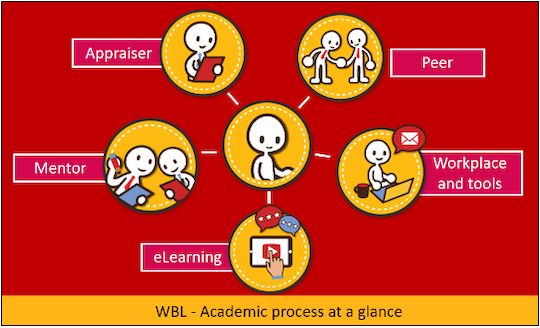
Figure 2: WBL academic process at a glance
The WBL ecosystem, including a real-life workplace, peers, appraisers, mentors and eLearning environment, contributes to offer ‘Learning through Working’ experience for WBL students (Namjoshi, 2020).
In the specific context of ‘no-workplace because of lockdown during COVID 19 pandemic’, for implementing the above mentioned model of WBL, specific challenges on the forefront were as follows.
According to estimates, India is the second largest market of freelance professionals (about 15 million), standing next to only the US (approximately 53 million). They contribute to about 40% of the total freelance jobs offered worldwide (Kathuria et al, 2017). India could have 20 million freelancers by 2025, with a market size estimated to grow to $20-30 billion (Gautam, 2018). As per Payoneer’s Freelancer Income Report 2020, the average hourly rate of Indian freelancers is $18.
Facts related to the gig economy worth considering are:
Parameters of Digital freelancing were mapped with WBL.
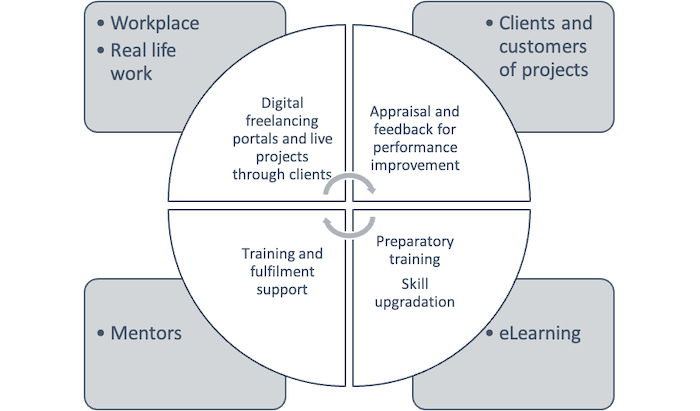
Figure 3: Digital Freelancing Parameters
Challenges and solutions:
|
Challenge |
Solution |
Workplace |
|
Appraiser |
|
Work-ratings |
|
Continuity of work |
|
Thus, the digital freelancing model attempts to offer a solution for various pedagogic challenges for sustaining WBL.
Mentors
Eight practicing digital freelancers with minimum of six months’ experience from Odisha, India were selected as mentors. Qualification: graduation, age group, 20-30 years.
Responsibilities taken up by mentors:
Mentors offered scaffolding (Sulzberger, 2015) continuously through WhatsApp/email and conducted daily interactions through video conferencing/audio calls, both individually and for small groups. Success stories of early birds, project links were shared within groups based on the skill set of the team members.
Activity
Steps involved in unfolding the digital freelancing activity:
Operational Framework
Dedicated Team: project manager, student facilitators, students’ WBL mentors (other than the digital freelancing mentors).
This team monitored the outcomes, implementation challenges, students’ feedback and responses. Immediate corrective actions were planned.
Daily Log Sheet: number of bids, number of students who submitted bids, cumulative record of project bids, number of projects awarded, earning details, etc. Comments from mentors and student facilitators helped in incorporating mid-course corrections.
Daily Work Report: students were required to upload daily work report. This was validated by mentors.Technology platform deployed for work-based degree students is used for the special activity of digital freelancing.
The Work-based Learning Management Framework is a comprehensive technology platform used by all the students of work-based degree programme. It offers learning management and WBL management functionalities to students including filling up of e-Workbook and work-reports (weekly, monthly, semesterly), which is most relevant to the digital freelancing activity.
Snapshots of work-reporting, interactions with mentor:
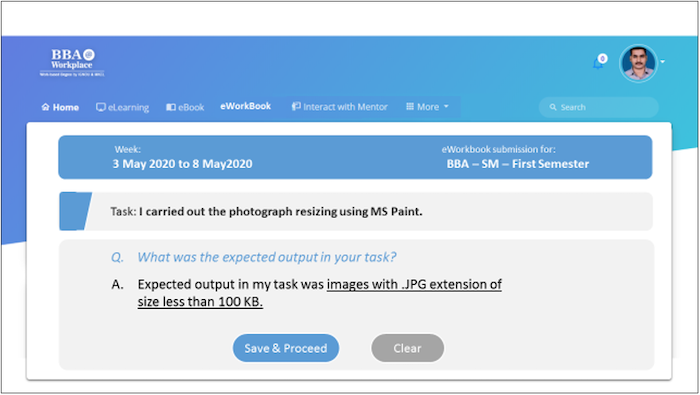
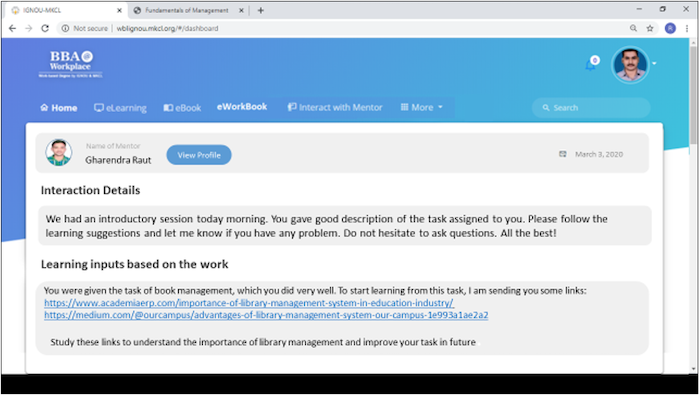
Key challenges during implementation:
Most of the students were unaware of Digital Freelancing. They had inhibitions about its authenticity and credibility and were hesitant to create profiles.
Solution: An orientation programme with high quality eLearning videos was designed. This included real examples of earnings. Project managers and student facilitators offered personal guidance.
Students were unaware of skill sets that could be mentioned in the profile, e.g., minimum skills required for translation jobs include proficiency in two languages. For app promotion, proficient spoken communication skills are essential.
Solution: Student facilitators and mentors interviewed students to identify skill sets based on the previous tasks performed at the workplace.
They offered scaffolds for the creation of appropriate profiles.
Mentors searched for appropriate jobs/projects for students.
Freelancing requires substantial time to establish a credible profile on the portal and attract good jobs and projects.
Solutions:
Few interested students faced challenges of poor Internet connectivity/access to laptop.
Solution: Students were exposed to mobile apps to take up projects that could be completed using smartphones.
E.g., one student completed a voiceover project using smartphone with limited Internet access. Another student completed a video editing project using the KineMaster app on his smartphone.
Social Background, Student Experiences
The social background and reflections of students are imperative for understanding the impact on their families, especially in view of the community challenges being addressed.
Representative student profiles, experiences collected through informal interviewing are mentioned.
Address: Wathar Nimbalkar, Maharashtra.
(2011 Census: Population —3954, Number of houses — 830. Female population — 49.1%. Village literacy rate — 71.7%, Female literacy rate — 32.1%.) (Villages-India, n.d.)
In a family of four, Amruta’s stipend was the only regular income source. Her mother is an ASHA worker (Accredited Social Health Activist), kept record of COVID positive patients’ families, carried high risk during pandemic. Amruta’s earning contributed to the psychological well-being of the family.
Project: On Freelancer.in, First earning — $10, 5-star rating. Project — Converting math research papers from PDF to Word.
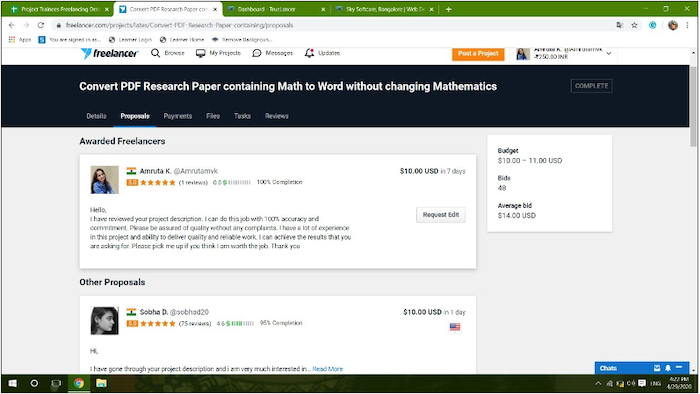
Address: Jalna, Maharashtra. (2011 Census — Total population — 285349) (Jalna)
Vaibhav, with a small family of three, was worried about his father, working in the health department as a supervisor. His family was surprised with his earnings sitting at home! They were happy to see him productively engaged when his friends sat idle during lockdown.
Project: WorkNHire, First earning — INR 1200. Project — Synching audio and video by referring the scripts.
Address: Ballarpur, Maharashtra. (2011 Census — Population 89,452) (Census, n.d.)
Members in family — 7. Rutika’s family income depends on labor-work under MGNREGA. Her family suffered a financial crisis during COVID-19.
Rutika is one of the top performers. She paid TYBBA fees from her earnings and plans to continue digital freelancing. She is now mentoring others.
Project: On Freelancer.in, First earning — $16. Project — Providing Marathi voiceover to messages in app.
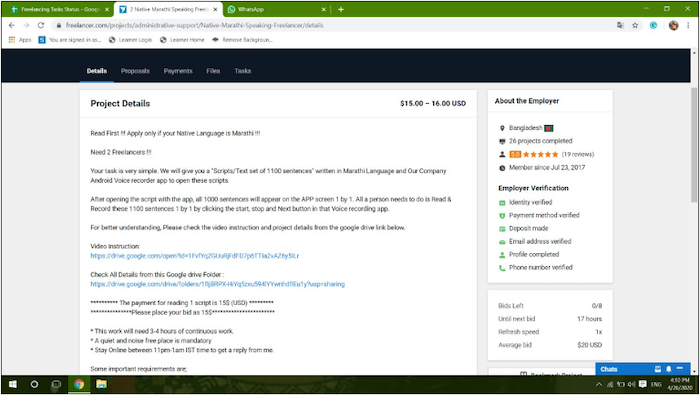
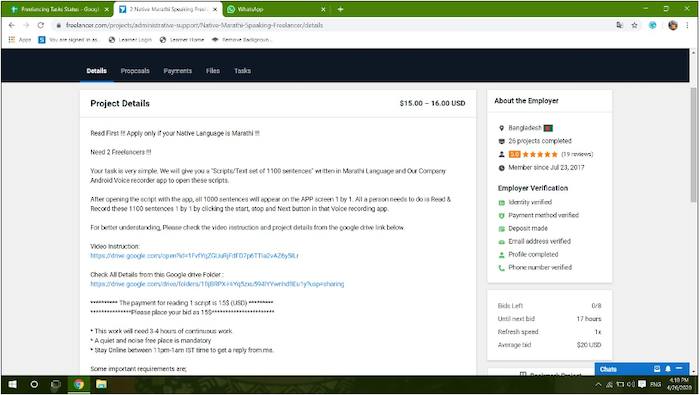
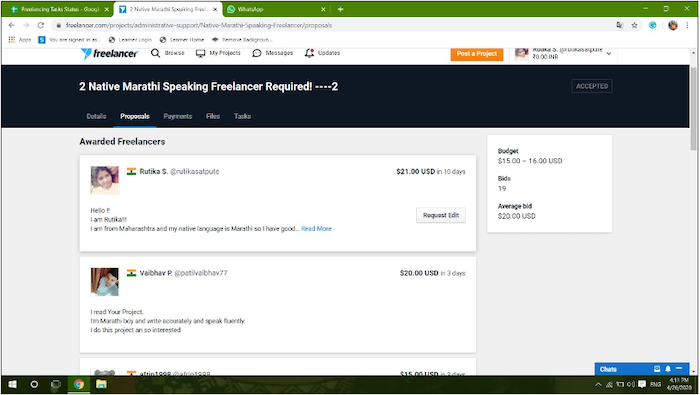
Address: Shahpur, Rohtas, Bihar. (2011 Census — Total population is 643, Number of houses — 105) (Villages-India, n.d.)
Amrish is one of the highest earners. He comes from a farming family.
Amrish was not sure about the credibility of digital freelancing. According to him, communication skills and understanding the actual price in the market are crucial.
Project: On Freelance.in, First earning — INR 400. Project — Tele-calling. He re-approached the client and gained the project.
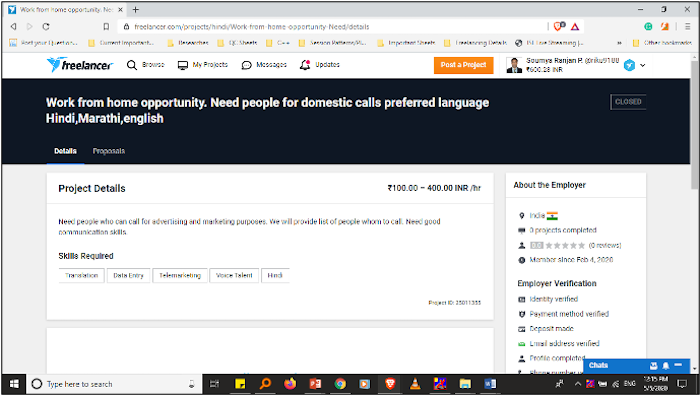
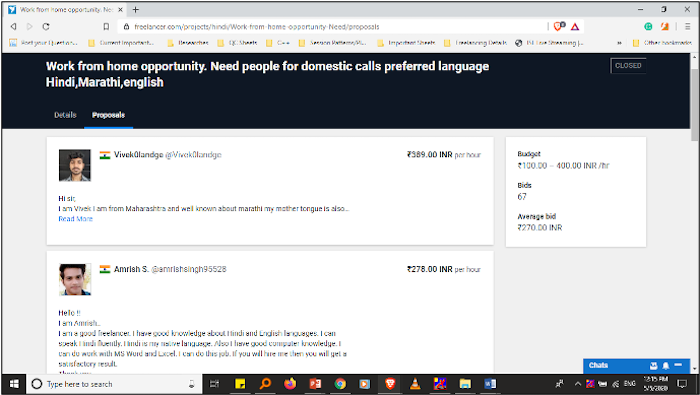
Address: Bhagpur, Nasik, Maharashtra. (Population — 12,353) (Census, n.d.)
Prasad doesn’t belong to the financially weaker section, however, the closing down of the family business (Computer Training Institute) increased the liabilities on each family member. His family is satisfied with his involvement and new way of earning.
Project: On WorkNHire.com. First earning — INR 320. Project — Blog writing.
The activity was initiated on March 26, 2020, i.e., on the next day after the declaration of lockdown in India.
It continued for 52 days, i.e., till May 30, 2020.
Sixty-one students were involved in the initial stage of the activity.
Ten percent of students continued to earn even after the scaffolding by mentors was discontinued.
Number of bids during these 52 days: 500 projects.
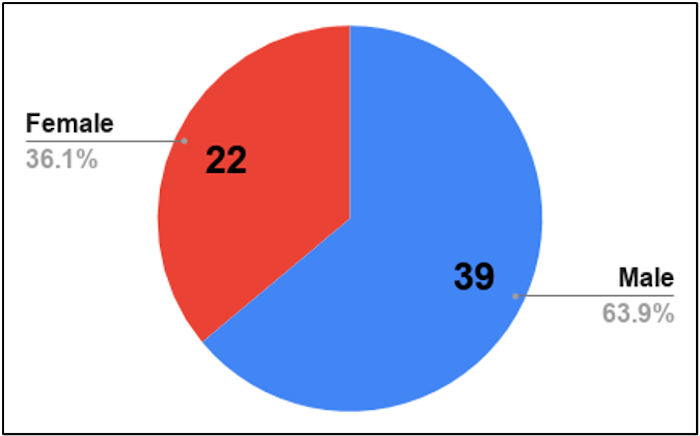
Skill Sets
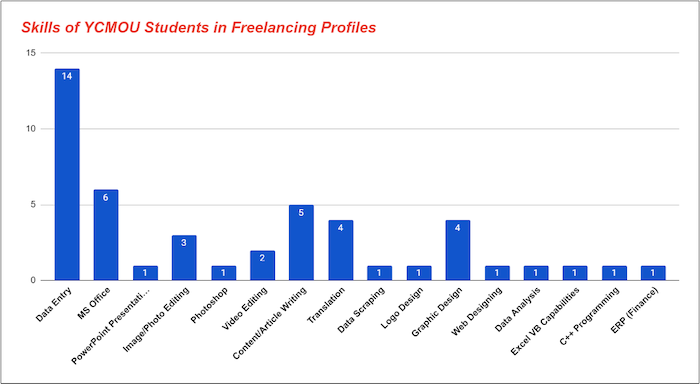
The total combined earnings of the students was INR 36,776.
Representative Student earning:
Amrish Singh: INR 18,800
Rutika Satpute: INR 9,866
Vaibhav Mandal: INR 3,700
Amruta Khopade: INR 2,850
Geeta Panchal: INR 1,140
Count of bids per month along with earnings per month. Initial 52 days were part of the core experiment.
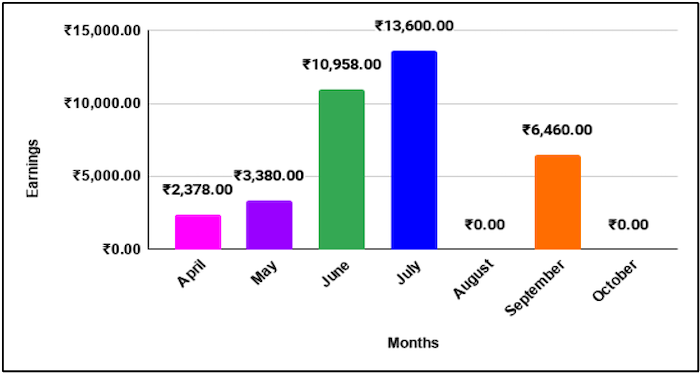
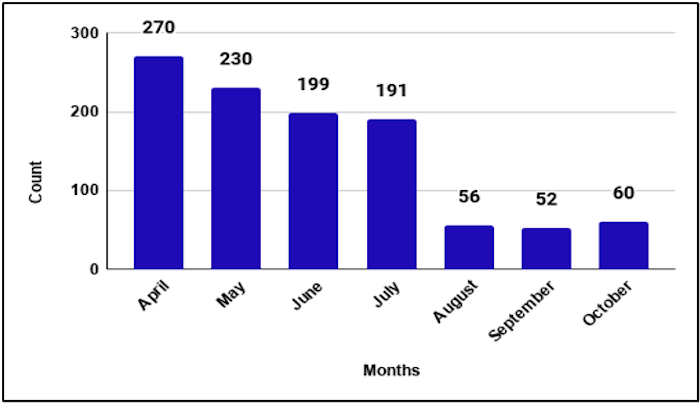
In view of the success of the digital freelancing activity for WBL students, the following spin-offs and future directions can be envisioned.
Projects on digital freelancing platforms are awarded based on skill sets, portfolios, i.e., evidence of earlier work and ratings. Special WBL degree programmes can be launched for digital freelancers. Main streaming in higher education can be achieved through this.
The case study demonstrates its effectiveness.
Digital Freelancing Hubs could be established through public-private partnerships. Such hubs could establish a network of mentors and freelancing facilitators and offer necessary IT infrastructure to budding digital freelancers. This could be an organized effort to further contribute to the global digital freelancing market.
Bergen, M., Eidlson, J. (2018, July 25). Inside Google's shadow workforce. Bloomberg. https://www.bloomberg.com/news/articles/2018-07-25/inside-google-s-shadow-workforce
Bhatia, P. (n.d.). Full time freelancer - India. MyHQ. https://digest.myhq.in/full-time-freelancer-india
Census 2011. (n.d.). Ballarpur Population Census 2011 - 2021. https://www.census2011.co.in/data/town/802724-ballarpur-maharashtra.html
Census 2011. (n.d.). Bhagur Population Census 2011 - 2021.
https://www.census2011.co.in/data/town/802778-bhagur-maharashtra.html
Gautam, A. (2018, April 2). L&D in the gig economy: Learn-tech to the rescue. The SHRM SouthAsiaBlog. https://blog.shrm.org/sasia/blog/ld-in-the-gig-economy-learn-tech-to-the-rescue
Jalna. (n.d.). https://cdn.s3waas.gov.in/s3d67d8ab4f4c10bf22aa353e27879133c/uploads/2018/03/2018030393.pdf
Kathuria, R., Kedia, M., Varma, G., Bagchi, K., & Khullar, S. (2017, December). Future of work in a digital era: The potential and challenges for online freelancing and microwork in India. Indian Council for Research on International Economic Relations.
MKCL. (2001). Work-based degree. ignou.mkcl.org
Namjoshi, R. (2017). Analytical study of effectiveness of elearning in role based and work and performance centric model for educational program implemented by MKCL. http://hdl.handle.net/10603/130343
Namjoshi, R. (2020). The role of industry in implementing Work-based Learning Pedagogy. Work Based Learning e-Journal International, 9(1), 132-146. https://wblearning-ejournal.com/en/volume-9,-issue-1,-june-2020---content-page
Payoneer. (n.d.). Payoneer’s Freelancer Income Report 2020.
Raelin, J. (2008). Work-based learning: Bringing knowledge and action in the workplace. Jossey-Bass Wiley Imprint.
Sawant, V. (2017, October 2). Unemployment, Quit India. In C. A. Welukar, Gandhi @ 150. Jaico Publishing House. https://books.google.co.in/books?id=1oWqDwAAQBAJ&lpg=PT5&ots=WlG7q6Fi62&dq=unemployment%20quit%20india%2C%20vivek%20sawant&pg=PT6#v=onepage&q=unemployment%20quit%20india,%20vivek%20sawant&
Sulzberger, L. A. (Ed.) (2015, June). A scaffolding approach. https://education.wm.edu/centers/ttac/documents/packets/writingprocess.pdf
Villages-India. (n.d.). https://www.onefivenine.com/india/villages/Satara/Phaltan/Wathar-_3animbalkar_4a
Villages-India. (n.d.). http://www.onefivenine.com/india/villages/Rohtas/Sheosagar/Shahpur
Authors:
Dr. Revati Namjoshi leads the Educational Transformation Program to implement Higher Education programs based on 'Nai-Talim' — Work-based learning methodology, School Education transformation programs through constructivist pedagogy and Teacher Education, with her research interest in techno-pedagogy, learning innovations for masses and learning experience designing. Email: revatinamjoshi@gmail.com
Soumya Pani implements learning strategies to enable learners in the field of digital freelancing as a Manager, Academics, with an interest in visualization, study of user responses and learning cum earning experience designing for youth. Email: soumyap@mkcl.org
Ujjwala Despande is an academic coordinator of work-based degree programs and contributes to mainstreaming of work-based education, specializes in work-based mentoring and reflections for learning with an interest in sociology of education. She is pursuing a PhD in social sciences. Email: ujjwalap@mkcl.org
Amit Ranade leads the Learning Innovation Program and contributes to the mission of bridging the digital divide through IT literacy and technology enabled education for masses, with an interest in researching advanced technology disruptions and practicing action research. Email: amitr@mkcl.org
Cite this paper as: Namjoshi, R., Pani, S., Despande, U., & Ranade, A. (2021). Sustaining work-based learning during the COVID-19 Pandemic. Journal of Learning for Development, 8(2), 412-430.